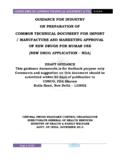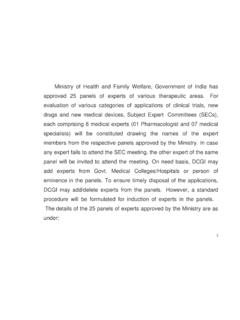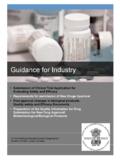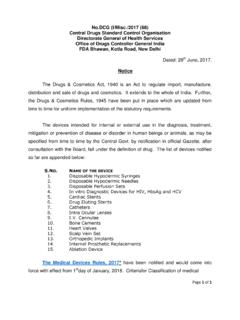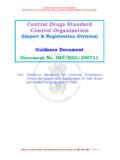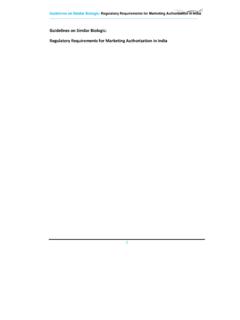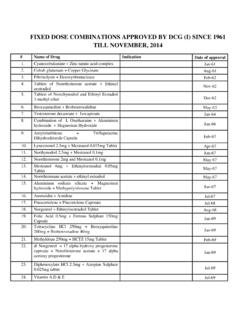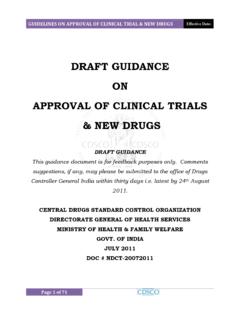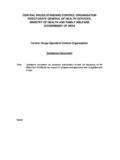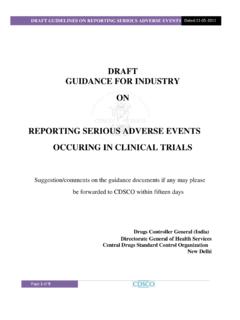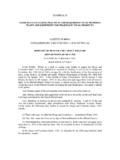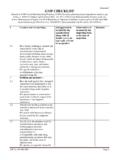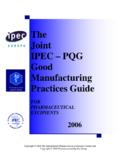Transcription of SCHEDULE M - Central Drugs Standard Control …
1 [ SCHEDULE M]. [See Rules 71, 74, 76 and 78]. good MANUFACTURING practices AND REQUIREMENTS OF PREMISES, PLANT AND EQUIPMENT for pharmaceutical PRODUCTS. Note: - To achieve the objectives listed below, each licensee shall evolve appropriate methodology, systems and procedures which shall be documented and maintained for inspection and reference; and the manufacturing premises shall be used exclusively for production of Drugs and no other manufacturing activity shall be undertaken therein. PART 1. good MANUFACTURING practices FOR PREMISES AND MATERIALS. 1. GENERAL REQUIREMENTS.
2 Location and The factory building(s) for manufacture of Drugs shall be so situated and shall have such measures as to avoid risk of contamination from external environmental including open sewage, drain, public lavatory or any factory which product disagreeable or obnoxious odour, fumes, excessive soot, dust, smoke, chemical or biological emissions. Building and The building(s) used for the factory shall be designed, constructed, adapted and maintained to suit the manufacturing operations so as to permit production of Drugs under hygienic conditions. They shall conform to the conditions laid down in the Factories Act, 1948 (63 of 1948).
3 The premises used for manufacturing, processing, warehousing, packaging labeling and testing purposes shall be . _____. _. Omitted by (E) (E) applicable to manufacturers licensed to manufacture Drugs , for the period upto (i) compatible with other drug manufacturing operations that may be carried out in the same or adjacent area / section;. (ii) adequately provided with working space to allow orderly and logical placement of equipment, materials and movement of personnel so as to: (a) avoid the risk of mix-up between different categories of Drugs or with raw materials, intermediates and in-process material.
4 (b) avoid the possibilities of contamination and cross- contamination by providing suitable mechanism;. (iii) designed / constructed / maintained to prevent entry of insects, pests, birds, vermins, and rodents. Interior surface (walls, floors and ceilings). shall be smooth and free from cracks, and permit easy cleaning, painting and disinfection;. (iv) air-conditioned, where prescribed for the operations and dosage froms under production. The production and dispensing areas shall be well lighted, effectively ventilated, with air Control facilities and may have proper Air Handling Units (wherever applicable) to maintain conditions including temperature and, wherever necessary, humidity, as defined for the relevant product.
5 These conditions shall be appropriate to the category of Drugs and nature of the operation. These shall also be suitable to the comforts of the personnel working with protective clothing, products handled, operations undertaken within them in relation to the external environment. These areas shall be regularly monitored for compliance with required specifications;. (v) Provided with drainage system, as specified for the various categories of products, which shall be of adequate size and so designed as to prevent back flow and/or prevent insets and rodents entering the premises.
6 Open channels shall be avoided in manufacturing areas and, where provided, these shall be shallow to facilitate cleaning and disinfection;. (vi) The walls and floors of the areas where manufacture of Drugs is carried out shall be free from cracks and open joints to avoid accumulation of dust. These shall be smooth, washable, covered and shall permit easy and effective cleaning and dis-infection. The interior surfaces shall not shed particles. A periodical record of cleaning and painting of the premises shall be maintained. Water System. - There shall be validated system for treatment of water drawn from own or any other source to render it potable in accordance with standards specified by the Bureau of Indian Standards or Local Municipality, as the case may be, so as to produce Purified Water conforming to Pharmacopoeial specification.
7 Purified Water so produced shall only be used for all operations except washing and cleaning operations where potable water may be used. Water shall be stored in tanks, which do not adversely affect quality of water and ensure freedom from microbiological growth. The tank shall be cleaned periodically and records maintained by the licensee in this behalf. Disposal of waste. - (i) The disposal of sewage and effluents (solid, liquid and gas) from the manufactory shall be in conformity with the requirements of Environment Pollution Control Board. (ii) All bio-medical waste shall be destroyed as per the provisions of the Bio-Medical Waste (Management and Handling) Rules, 1996.
8 (iii) Additional precautions shall be taken for the storage and disposal of rejected Drugs . Records shall be maintained for all disposal of waste. (iv) Provisions shall be made for the proper and safe storage of waste materials awaiting disposal. Hazardous,toxic substances and flammable materials shall be stored in suitably designed and segregated, enclosed areas in conformity with Central and State Legislations. 2. Warehousing Area. - Adequate areas shall be designed to allow sufficient and orderly warehousing of various categories of materials and products like starting and packaging materials, intermediates, bulk and finished products, products in quarantine, released, rejected, returned or recalled, machine and equipment spare parts and change items.
9 Warehousing areas shall be designed and adapted to ensure good storage conditions. They shall be clean, dry and maintained with acceptable temperature limits, where special storage conditions are required ( temperature, humidity), these shall be provided, monitored and recorded. Storage areas shall have appropriate house-keeping and rodent, pests and vermin Control procedures and records maintained. Proper racks, bins and platforms shall be provided for the storage of materials. Receiving and dispatch bays shall protect materials and products from adverse weather conditions.
10 Where quarantine status is ensured by warehousing in separate earmarked areas in the same warehouse or store, these areas shall be clearly demarcated. Any system replacing the physical quarantine, shall give equivalent assurance of segregation. Access to these areas shall be restricted to authorized persons. There shall be a separate sampling area in the warehousing area for active raw materials and excipients. If sampling is performed in any other area, it shall be conducted in such a way as to prevent contamination, cross-contamination and mix-up. Segregation shall be provided for the storage of rejected, recalled or returned materials or products.
